
By Ginger Nickerson, UVM Extension
When you are in your sugarbush this winter, be on the lookout for signs of Asian longhorned beetle (ALB). ALB is a wood-boring insect, native to southeast Asia.
This highly destructive pest will kill many hardwood trees. However, its preferred host is the beloved maple. It has not yet been confirmed in Vermont. However, there is an active infestation in Worcester County, Massachusetts. The beetle threatens all species of maples. It is spread through moving infested firewood, nursery stock, or infested wood products.
While the summer and early fall are the best times to see the adult beetles, winter is an excellent time to examine your trees for signs of ALB damage. Take pictures of any signs you see and report suspicious trees to VTinvasives.org.
Signs To Look For:

Multiple round, shallow indentations in the bark with rough edges. These are dime-sized spots the beetles chew to lay their eggs. The spots may ooze sap in the summer and fall when they are fresh.

Perfectly round, pencil to dime-sized holes. These are left when the adults emerge in the summer. The exit hole will be straight and at least one inch deep. Stick a pencil in the hole to test if it is deeper than a tap hole. There may be bits of sawdust-like material around these holes, in branch crooks, or at the base of the tree.
In addition to attacking all maple species, ALB will also harm healthy ash, poplar, birch, willow, and elm.
Let’s keep Vermont’s maples ALB free!

